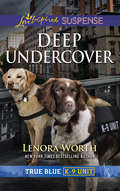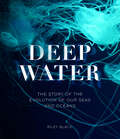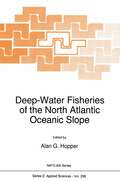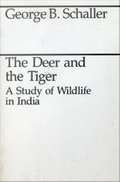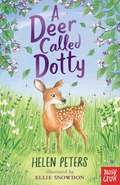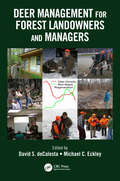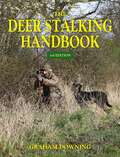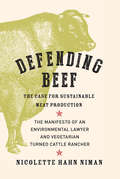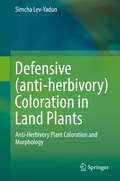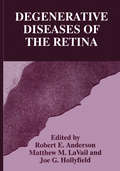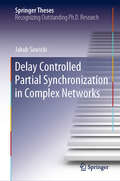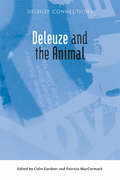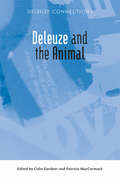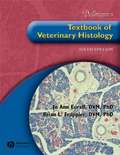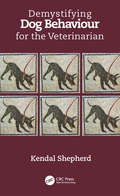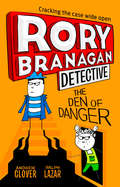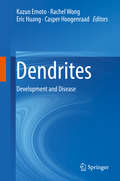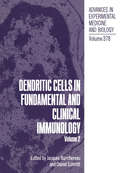- Table View
- List View
Deep Undercover: Undercover Memories In Too Deep Framed For Christmas (True Blue K-9 Unit #5)
by Lenora WorthA dangerous undercover assignment… Another exciting True Blue K-9 Unit thriller
Deep Water: The Story of the Evolution of Our Seas and Oceans
by Riley BlackWhat lies beneath the surface of the ocean has mystified humankind for millennia.We have explored more of the surface of the Moon than we have of the deep sea. From vampire squid to giant spider crabs, and from hydrothermal vents to bioluminescence, its watery depths are both fascinating and terrifying.Deep Water explores, through spectacular images and expert text, how this unique habitat came into being, what lives there and why, how it has evolved and what the future will bring for this dark and mysterious environment.
Deep-Water Fisheries of the North Atlantic Oceanic Slope (NATO Science Series E: #296)
by Alan G. HopperA comprehensive review of current knowledge of the deep-water fishes of the North Atlantic and their exploitation. Individual countries and research institutions have carried out their own investigations and surveys in the past, but these results have rarely been coordinated, nor has there been a proper sharing of results and data. But there is a need to assess the total size of the deep-water stocks and the extent to which they can safely be exploited. The book also contains a number of papers describing present and past research and the present exploitation of resources, together with papers on the technical problems encountered in capturing and processing these fishes. An assessment of the requirements for future research is presented.
The Deer and the Tiger: Study of Wild Life in India
by George B. SchallerThe Deer and the Tiger is Schaller's detailed account of the ecology and behavior of Bengal tigers and four species of the hoofed mammals on which they prey, based on his observations in India's Kanha National Park. "This book is a treasure house of biological information and it is also a delight to read. . . . Excellent phoographs accompany the text."—Robert K. Enders, American Scientist "The one book that has been my greatest source of inspiration is The Deer and the Tiger by George Schaller, based on the first ever scientific field study of the tiger. . . . This book is written by a scientist, but speaks from the heart. . . . It reveals startling information on feeding habitats, territorial behaviour, and the nuances that make up the language of the forest; you become totally immersed in the world of the tiger. . . . For all of us who work in tiger conservation, this book is the bible."—Valmik Thapar, BBC Wildlife
The Deer and the Tiger: Study of Wild Life in India
by George B. SchallerThe Deer and the Tiger is Schaller's detailed account of the ecology and behavior of Bengal tigers and four species of the hoofed mammals on which they prey, based on his observations in India's Kanha National Park. "This book is a treasure house of biological information and it is also a delight to read. . . . Excellent phoographs accompany the text."—Robert K. Enders, American Scientist "The one book that has been my greatest source of inspiration is The Deer and the Tiger by George Schaller, based on the first ever scientific field study of the tiger. . . . This book is written by a scientist, but speaks from the heart. . . . It reveals startling information on feeding habitats, territorial behaviour, and the nuances that make up the language of the forest; you become totally immersed in the world of the tiger. . . . For all of us who work in tiger conservation, this book is the bible."—Valmik Thapar, BBC Wildlife
A Deer Called Dotty (The Jasmine Green Series #9)
by Helen PetersJasmine's dad is a farmer, and her mum is a large-animal vet, so Jasmine spends a lot of time caring for animals and keeping them out of trouble. Unfortunately, this often means she gets into hot water herself... A perfect animal story for younger readers by Waterstones Children's Book Prize-shortlisted author Helen Peters, with beautiful black-and-white illustrations by Ellie Snowdon. Jasmine's mother is called to help a pregnant deer who has been hit by a car. She performs an emergency Caesarean and delivers tiny, helpless Dotty, before handing her over to Jasmine to raise... Brilliant storytelling that will make you laugh and cry, this is Dick King-Smith for a new generation. Look out for Jasmine's other adventures!A Piglet Called TruffleA Duckling Called ButtonA Sheepdog Called SkyA Kitten Called HollyA Lamb Called LuckyA Goat Called WillowAn Otter Called PebbleAn Owl Called Star
Deer Head (large print)
by RnibThis page shows an image of a deer's head shown from the front. There is a locator dot shown, which will be at the top left of the page when the image is the correct way up. The tips of the deer's two large ears are at the top left and right of the page. They lead down to the top of the brown head in the centre of the page. Down from the ears there is a large black eye to the left and right. In the bottom centre of the image is the deer's large black nose. The tip of the head is paler and there is a small patch of white under its chin.
Deer Head (UEB contracted)
by RnibThis page shows an image of a deer's head shown from the front. There is a locator dot shown, which will be at the top left of the page when the image is the correct way up. The tips of the deer's two large ears are at the top left and right of the page. They lead down to the top of the brown head in the centre of the page. Down from the ears there is a large black eye to the left and right. In the bottom centre of the image is the deer's large black nose. The tip of the head is paler and there is a small patch of white under its chin.
Deer Head (UEB uncontracted)
by RnibThis page shows an image of a deer's head shown from the front. There is a locator dot shown, which will be at the top left of the page when the image is the correct way up. The tips of the deer's two large ears are at the top left and right of the page. They lead down to the top of the brown head in the centre of the page. Down from the ears there is a large black eye to the left and right. In the bottom centre of the image is the deer's large black nose. The tip of the head is paler and there is a small patch of white under its chin.
Deer Management for Forest Landowners and Managers
by David S. deCalesta and Michael C. EckleyThis book is designed to help landowners and forestry professionals develop, implement, and monitor programs to manage both deer and forests with emphasis on resolving deer impact issues. Chapters cover management strategies through identifying and setting goals; managing deer populations and deer impact on land; economics of forest, deer, and impact management; human dimensions of deer management; and developing and implementing integrated management plans. The book presents an integrated, quantitative approach for managing deer populations and impacts so users can manage forest resources sustainably.
Deer Management for Forest Landowners and Managers
by David S. DeCalesta Michael C. EckleyThis book is designed to help landowners and forestry professionals develop, implement, and monitor programs to manage both deer and forests with emphasis on resolving deer impact issues. Chapters cover management strategies through identifying and setting goals; managing deer populations and deer impact on land; economics of forest, deer, and impact management; human dimensions of deer management; and developing and implementing integrated management plans. The book presents an integrated, quantitative approach for managing deer populations and impacts so users can manage forest resources sustainably.
The Deer Stalking Handbook
by Graham DowningDeer stalking is widely regarded as the fastest growing sector within shooting sports in Britain today. Those who stalk deer for sport recognise and appreciate the exciting challenge that comes from hunting a wild and wary quarry, moreover, they enjoy the opportunity to participate in a sport that can take them to some of Britain’s wildest and most beautiful places, from the hushed calm of an ancient English forest at dawn, to the magnificence of the Scottish hill. Successful stalking, however, demands a high level of knowledge and skill. Much of this can only be learned through long hours of apprenticeship and experience. This book provides a basic grounding in the principles which the newcomer to the sport needs to know in order to enjoy a safe, successful and responsible stalking career. The author explains the history, background and rationale behind deer stalking in the UK, covers the choice of stalking rifles, optics, ammunition and accessories, and deals with the all-important issue of safety. The law related to firearms and deer is covered in detail, together with guidance on firearm security in the home and when travelling, while the natural history of Britain’s six species of wild deer is described, with notes and illustrations to assist with recognition. Stalking tactics are discussed and explained from the perspective both of the stalking guest who is accompanied by a professional guide and of the more experienced hunter whose responsibility it is to plan and execute a woodland stalking outing on his own. Finally, the book deals with what the stalker must do should his day meet with success, from the gralloch and preparation of the carcass for the game dealer, through to butchering for the home kitchen. Here is a book to which the amateur deer stalker will want to refer time and time again.
Defending Beef: The Case for Sustainable Meat Production
by Nicolette Hahn NimanFor decades it has been nearly universal dogma among environmentalists and health advocates that cattle and beef are public enemy number one. But is the matter really so clear cut? Hardly, argues environmental lawyer turned rancher Nicolette Hahn Niman in her new book, Defending Beef. The public has long been led to believe that livestock, especially cattle, erode soils, pollute air and water, damage riparian areas, and decimate wildlife populations. In Defending Beef, Hahn Niman argues that cattle are not inherently bad for either the Earth or our own nutritional health. In fact, properly managed livestock play an essential role in maintaining grassland ecosystems by functioning as surrogates for herds of wild ruminants that once covered the globe. Hahn Niman argues that dispersed, grass-fed, small-scale farms can and should become the basis for American food production, replacing the factory farms that harm animals and the environment. The author—a longtime vegetarian—goes on to dispel popular myths about how eating beef is bad for our bodies. She methodically evaluates health claims made against beef, demonstrating that such claims have proven false. She shows how foods from cattle—milk and meat, particularly when raised entirely on grass—are healthful, extremely nutritious, and an irreplaceable part of the world’s food system. Grounded in empirical scientific data and with living examples from around the world, Defending Beef builds a comprehensive argument that cattle can help to build carbon-sequestering soils to mitigate climate change, enhance biodiversity, help prevent desertification, and provide invaluable nutrition. Defending Beef is simultaneously a book about big ideas and the author’s own personal tale—she starts out as a skeptical vegetarian and eventually becomes an enthusiastic participant in environmentally sustainable ranching. While no single book can definitively answer the thorny question of how to feed the Earth’s growing population, Defending Beef makes the case that, whatever the world’s future food system looks like, cattle and beef can and must be part of the solution.
Defensive (anti-herbivory) Coloration in Land Plants: Anti-herbivory Plant Coloration And Morphology
by Simcha Lev-YadunThis book presents visual plant defenses (camouflage, mimicry and aposematism via coloration, morphology and even movement) against herbivores. It is mainly an ideological monograph, a manifesto representing my current understanding on defensive plant coloration and related issues. The book is not the final word in anything, but rather the beginning of many things. It aims to establish visual anti-herbivory defense as an integral organ of botany, or plant science as it is commonly called today. I think that like in animals, many types of plant coloration can be explained by selection associated with the sensory/cognitive systems of herbivores and predators to reduce herbivory. It is intended to intrigue and stimulate students of botany/plant science and plant/animal interactions for a very long time. This book is tailored to a readership of biologists and naturalists of all kinds and levels, and more specifically for botanists, ecologists, evolutionists and to those interested in plant/animal interactions. It is written from the point of view of a naturalist, ecologist and evolutionary biologist that I hold, considering natural selection as the main although not the only drive for evolution. According to this perspective, factors such as chance, founder effects, genetic drift and various stochastic processes that may and do influence characters found in specific genotypes, are not comparable in their power and influence to the common outcomes of natural selection, especially manifested when very many species belonging to different plant families, with very different and separate evolutionary histories, arrive at the same adaptation, something that characterizes many of the visual patterns and proposed adaptations described and discussed in this book. Many of the discussed visual defensive mechanisms are aimed at operating before the plants are damaged, i.e., to be their first line of defense. In this respect, I think that the name of the book by Ruxton et al. (2004) "Avoiding Attack" is an excellent phrase for the assembly of the best types of defensive tactics. While discussing anti-herbivory, I do remember, study and teach physiological/developmental aspects of some of the discussed coloration patterns, and I am fully aware of the simultaneous and diverse functions of many plant characters in addition to defense.
Degenerative Diseases of the Retina: Proceedings Of The Sixth International Symposium Held In Jerusalem, Israel, November 4-9, 1994
by Joe G. Hollyfield Matthew M. LaVail Robert E. AndersonIn 1984, we organized a two-day symposium on retinal degenerations as part of the biennial meeting of the VI International Society for Eye Research, held in Alicante, Spain. The success of this first meeting led to the second held, two years later in Sendai, Japan, organized as a satellite of the VII ISER. We were fortunate that these meetings began at a time of vigorous research activity in the area of retinal degenerations, thanks to the financial support of the Retinitis Pigmentosa Foundation and the strong encouragement of its scientific director, Dr. Alan Laties. Significant advances were made so that every two years scientists were eager to meet to share their findings. The programs included presentations by both basic and clinical researchers with ample time for informal discussions in a relaxed atmos phere. Many investigators met for the first time at these symposia and a number of fruitful collaborations were established. This book contains the proceedings of the VI International Symposium on Retinal Degenerations held November 6-10, 1994, in Jerusalem. As with the other meetings, some new areas were covered. One session was devoted to apoptosis, an important process involved in cell death in inherited retinal degenerations. Another session was on invertebrate photoreceptors, where numerous mutations have now been identified that lead to altered function or degeneration of the retina. All participants were invited to submit chapters and most complied. We thank them for their contributions.
Delay Controlled Partial Synchronization in Complex Networks (Springer Theses)
by Jakub SawickiThe focus of this thesis are synchronization phenomena in networks and their intrinsic control through time delay, which is ubiquitous in real-world systems ranging from physics and acoustics to neuroscience and engineering. We encounter synchronization everywhere and it can be either a helpful or a detrimental mechanism. In the first part, after a survey of complex nonlinear systems and networks, we show that a seemingly simple system of two organ pipes gives birth to complex bifurcation and synchronization scenarios. Going from a 2-oscillator system to a ring of oscillators, we encounter the intriguing phenomenon of chimera states which are partial synchrony patterns with coexisting domains of synchronized and desynchronized dynamics. For more than a decade scientist have tried to solve the puzzle of this spontaneous symmetry-breaking emerging in networks of identical elements. We provide an analysis of initial conditions and extend our model by the addition of time delay and fractal connectivities. In the second part, we investigate partial synchronization patterns in a neuronal network and explain dynamical asymmetry arising from the hemispheric structure of the human brain. A particular focus is on the novel scenario of partial relay synchronization in multiplex networks. Such networks allow for synchronization of the coherent domains of chimera states via a remote layer, whereas the incoherent domains remain desynchronized. The theoretical framework is demonstrated with different generic models.
Deleuze and the Animal (Deleuze Connections)
by Colin Gardner Patricia MacCormackBecoming-animal is a key concept for Deleuze and Guattari; the ambiguous idea of the animal as human and nonhuman life infiltrates all of Deleuze’s work. These 16 essays apply Deleuze’s work to analysing television, film, music, art, drunkenness, mourning, virtual technology, protest, activism, animal rights and abolition. Each chapter questions the premise of the animal and critiques the centrality of the human. This collection creates new questions about what the age of the Anthropocene means by ‘animal’ and analyses and explores examples of the unclear boundaries between human and animal.
Deleuze and the Animal (Deleuze Connections)
by Colin Gardner Patricia MacCormackBecoming-animal is a key concept for Deleuze and Guattari; the ambiguous idea of the animal as human and nonhuman life infiltrates all of Deleuze’s work. These 16 essays apply Deleuze’s work to analysing television, film, music, art, drunkenness, mourning, virtual technology, protest, activism, animal rights and abolition. Each chapter questions the premise of the animal and critiques the centrality of the human. This collection creates new questions about what the age of the Anthropocene means by ‘animal’ and analyses and explores examples of the unclear boundaries between human and animal.
Dellmann's Textbook of Veterinary Histology
by Jo Ann Eurell Brian L. FrappierThe leading veterinary histology text returns with a fully updated sixth edition. Written in a concise, easy-to-understand that's a pleasure to read, this new edition continues the student-friendly tradition originated by Dr. Dellman, presenting the basics of histology including cytology and microscopic anatomy. The Sixth Edition focuses on the most current knowledge of cell, tissue and organ structure and function. All information has been fully revised and updated by the authors, both experts in their fields. Written with first year veterinary students in mind, it is also an important resource for veterinarians, graduate students, and others who require information on animal tissue structure and function. Highlights of the Sixth Edition include: New images and line drawings have been added to enhance the student's understanding of concepts. Two-page insert contains full-color histology images. Comprehensive listings of suggested readings at the end of each chapter encourage further study. The text is organized by body region, allowing the presentation to emphasize comparative species information so students can better appreciate how species differ in regard to key structures. Whether you're a veterinary student or practicing professional, you should have this classic histology reference as part of your working library.
Dellmann's Textbook of Veterinary Histology
by Jo Ann Eurell Brian L. FrappierThe leading veterinary histology text returns with a fully updated sixth edition. Written in a concise, easy-to-understand that's a pleasure to read, this new edition continues the student-friendly tradition originated by Dr. Dellman, presenting the basics of histology including cytology and microscopic anatomy. The Sixth Edition focuses on the most current knowledge of cell, tissue and organ structure and function. All information has been fully revised and updated by the authors, both experts in their fields. Written with first year veterinary students in mind, it is also an important resource for veterinarians, graduate students, and others who require information on animal tissue structure and function. Highlights of the Sixth Edition include: New images and line drawings have been added to enhance the student's understanding of concepts. Two-page insert contains full-color histology images. Comprehensive listings of suggested readings at the end of each chapter encourage further study. The text is organized by body region, allowing the presentation to emphasize comparative species information so students can better appreciate how species differ in regard to key structures. Whether you're a veterinary student or practicing professional, you should have this classic histology reference as part of your working library.
Demystifying Dog Behaviour for the Veterinarian
by Kendal ShepherdThe behaviour textbook that's been missing! - Dr Mandy Roshier, University of Nottingham, School of Veterinary Medicine and Science, UK This practical guide for busy veterinarians demystifies the apparently complex nature of canine behaviour while simultaneously emphasising its importance. Authored by acclaimed veterinary behaviour consultant Kendal Shepherd, the book provides practical knowledge of dog behaviour and an understanding of how to talk about it with clients. Shepherd shows how this can enhance the relationship between owner and pet and between dog and environment, including the vet surgery, as well as improve the vet’s own sense of fulfilment and enjoyment of practice. From a discussion on the true nature of obedience to stressing the importance of behavioural indicators when assessing pain and mental welfare and finally by reminding vets of their obligations under Dangerous Dogs legislation, the emphasis is on the prevention of aggression throughout. Packed with anecdotes drawn from real-life cases, easy to read and understand, the principles explained can be effortlessly assimilated into the average consultation without the need for lengthy report-writing.
Demystifying Dog Behaviour for the Veterinarian
by Kendal ShepherdThe behaviour textbook that's been missing! - Dr Mandy Roshier, University of Nottingham, School of Veterinary Medicine and Science, UK This practical guide for busy veterinarians demystifies the apparently complex nature of canine behaviour while simultaneously emphasising its importance. Authored by acclaimed veterinary behaviour consultant Kendal Shepherd, the book provides practical knowledge of dog behaviour and an understanding of how to talk about it with clients. Shepherd shows how this can enhance the relationship between owner and pet and between dog and environment, including the vet surgery, as well as improve the vet’s own sense of fulfilment and enjoyment of practice. From a discussion on the true nature of obedience to stressing the importance of behavioural indicators when assessing pain and mental welfare and finally by reminding vets of their obligations under Dangerous Dogs legislation, the emphasis is on the prevention of aggression throughout. Packed with anecdotes drawn from real-life cases, easy to read and understand, the principles explained can be effortlessly assimilated into the average consultation without the need for lengthy report-writing.
The Den of Danger (Rory Branagan (Detective) #6)
by Andrew CloverMeet RORY BRANAGAN – he eats bad guys for breakfast. Well, not ACTUALLY. But he IS the best detective in town. Sixth in a hilarious comedy-crime series for readers of 8+.
Dendrites: Development and Disease
by Kazuo Emoto Rachel Wong Eric Huang Casper HoogenraadStudies in human patients and animal models of disease suggest a strong correlation between defects in dendrite development and common neurological disorders such as autism. Much of this book is thus dedicated toward highlighting recent advances in our understanding of the cellular and molecular mechanisms that regulate the development and maintenance of dendrites, a crucial component of neurons. The book begins by presenting the current state of knowledge on the building blocks or cell biology of dendrites. Mechanisms that sculpt the stereotypic architecture of dendritic arbors and shape their connectivity are also discussed, along with recent work describing how dendritic organization and connectivity are perturbed in disease. A unique aspect of the book is its exploration of diverse neuronal cell types across vertebrates and invertebrates, allowing a comparison of mechanisms across distinct circuits and species. The book comprises six parts, which cover the major advances in the field: Part 1, Introduction; Part 2, Basic Biology of Dendrites; Part 3, Patterning Dendritic Architecture of Neurons and Their Populations; Part 4, Cellular and Molecular Control of Dendrite Development and Maintenance; Part 5, Synapse Formation onto Dendrites; and Part 6, Dendrites in Disease. The book offers an excellent point of entry for students interested in neuroscience, as well as for clinicians.
Dendritic Cells in Fundamental and Clinical Immunology: Volume 2 (Advances in Experimental Medicine and Biology #378)
by Jacques Banchereau Daniel SchmittThese Proceedings contain the contributions of the partIcIpants of the Third International Symposium on Dendritic Cells that was held in Annecy, France, from June 19 to June 24, 1994. This symposium represented a follow-up of the first and second international symposia that were held in Japan in 1990 and in the Netherlands in 1992. Dendritic cells are antigen-presenting cells, and are found in all tissues and organs of the body. They can be classified into: (1) interstitial dendritic cells of the heart, kidney, gut, and lung;(2) Langerhans cells in the skin and mucous membranes; (3) interdigitating dendritic cells in the thymic medulla and secondary lymphoid tissue; and (4) blood dendritic cells and lymph dendritic cells (veiled cells). Although dendritic cells in each of these compartments are all CD45+ leukocytes that arise from the bone marrow, they may exhibit differences that relate to maturation state and microenvironment. Dendritic cells are specialized antigen-presenting cells for T lymphocytes: they process and present antigens efficiently in situ, and stimulate responses from naive and memory T cells in the paracortical area of secondary lymphoid organs. Recent evidence also demonstrates their role in induction of tolerance. By contrast, the primary and secondary B-cell follicles contain follicular dendritic cells that trap and retain intact antigen as immune complexes for long periods of time. The origin of follicular dendritic cells is not clear, but most investigators believe that these cells are not leukocytes.
